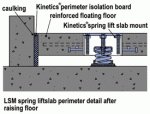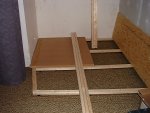The Niz
New member
Howdie to you all,
Currently I'm soundtreating my attic for turning it into a small homestudio (for personal usage only).
I've read a lot about soundproofing basics on the web (SAE, John Sayers site, this forum, etc) and I've read some books on the topic, but I've still got a question about the next step to tackle: the floating floor.
The attached jpg shows what I'm planning to do. I've got all the material ready to do it, my question is the following:
As you can see on the jpg (hopefully, if I succeed to attach it ;-), the actual floor will be 2 layers of 18mm x 2 = 36mm MDF right on top of each other. As I still have plenty of this "car seat fabric" left, I was thinking what would be the best thing to do in order to have the best sound proofing results:
option1: leave it like in the drawing (2 layers MDF on top of each other)
option2: put an extra layer of car seat fabric inbetween the 2 MDF-boards.
Would this be worth the extra effort? Or wouldn't it make a lot of difference?
Are there other suggestions or tips on the design of the floor or simple things I can do differently to have the maximum degree of soundproofing possible with the materials as shown?
I'm very curious about your comments. Thanks in advance!
Greetings,
The Niz
Currently I'm soundtreating my attic for turning it into a small homestudio (for personal usage only).
I've read a lot about soundproofing basics on the web (SAE, John Sayers site, this forum, etc) and I've read some books on the topic, but I've still got a question about the next step to tackle: the floating floor.
The attached jpg shows what I'm planning to do. I've got all the material ready to do it, my question is the following:
As you can see on the jpg (hopefully, if I succeed to attach it ;-), the actual floor will be 2 layers of 18mm x 2 = 36mm MDF right on top of each other. As I still have plenty of this "car seat fabric" left, I was thinking what would be the best thing to do in order to have the best sound proofing results:
option1: leave it like in the drawing (2 layers MDF on top of each other)
option2: put an extra layer of car seat fabric inbetween the 2 MDF-boards.
Would this be worth the extra effort? Or wouldn't it make a lot of difference?
Are there other suggestions or tips on the design of the floor or simple things I can do differently to have the maximum degree of soundproofing possible with the materials as shown?
I'm very curious about your comments. Thanks in advance!
Greetings,
The Niz

 I'm still worried about the carpet - waiting for John's response.
I'm still worried about the carpet - waiting for John's response.
